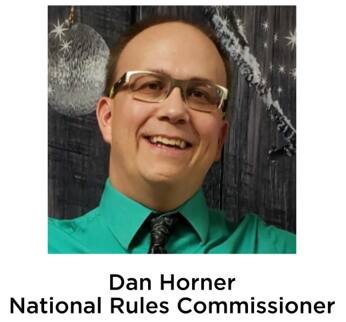
July 2022 Rules Rule
by Dan Horner, National Rules Commissioner

I want to welcome all the Rules Rule! readers to the beginning of another sure-to-be great season of racquetball. As I write this, we are 3 weeks from the start of the US OPEN. What an exciting way to kick off the season every year! If any readers have not been there before, you should give it a try. If that isn’t possible for you, then plan to watch the live-streamed action every day!
Let’s dive into some questions I’ve received recently:
Q1. I am hoping to get your expert advice. I was playing racquetball tonight and during a return, the racquetball got stuck in the strings of my racquet. Do you play the point over, or is it the opponent’s point? Is there a specific rule that I can reference?
A1. The scenario you described would be a loss of rally by you, so it would be a side out or point for your opponent based on who was serving at the time. To find the specific rule go to Rule 3.13(d)--Rallies-Failure to Return where you will see 10 different ways that a legal return fails to occur, thus ending the rally. Rule 3.13(d)(10) states that one of the ways to fail to return the ball properly is "Intentionally carrying or slinging the ball with the racquet. Also, the ball becoming lodged in one's strings or clothing."
Q2. In a doubles game, one of my opponents strikes the ball from the left side of court to the right side. My partner gets into position in an attempt to return, but my opponent’s partner is on the wall backing up to get out of the way. The ball is so close to my opponent’s partner that my partner holds up and calls a hinder. Right after that, the ball hits my opponent’s partner, as he thought my partner was going to take the shot. Would this be a point or side out for my team? The opponent that was hit by the ball says that because the hinder was called before the ball hit him, it is a replay hinder!
A2. I am assuming you were playing a self-ref match. The self-referee rules can be found in section D of the 2020 Rulebook beginning on page 41. Of course, the rest of the rules apply as well, and any time a hinder is called, whether by a referee or by the hindered player directly (in a self-ref match), anything that occurs after that call is null and void. So, your opponent is correct in that the rally should be replayed.
Q3. What is the rule when the ball hits any wall at the "crotch" -- that is, when it hits the place where the wall meets the floor and takes a very unusual bounce? Is that a do-over? My partner and I play at the UC San Francisco gym, where there is a good 1/8-1/4 inch gap that causes an unpredictable bounce.
A3. My first question for you is, are you talking about the ball hitting the crotch on the serve or during the rally? If it is during the rally, then the ball is always in play when it hits the crotch unless it hits the where the front wall meets the floor. However, if it is during the serve it depends on which wall it hits. Rule 3.10(g) says: "Crotch Serve. Any served ball that hits the crotch of the front wall and floor, front wall and side wall, or front wall and ceiling is an out serve (because it did not hit the front wall first). This includes the ball touching two intersecting surfaces at nearly the same time -- such that which one it touched first cannot be ascertained. However, a serve into the crotch formed by the back wall and floor, as well as the crotch formed by either sidewall beyond the short line, is a good serve and in play."
Now it sounds like your court has an unusual gap where the wall meets the floor. If you and your opponent are playing in a non-tournament match, you could just agree ahead of time to replay any crotch shots on that wall. However, if this is during a tournament it would be the tournament director who would need to make that decision in advance and inform players and referees before competition begins.
Q4. Please explain what appears to be a contradictory set of rules. Rule 3.13 states, “If a player swings at the ball and misses it, the player or their partner may continue to attempt to return the ball.” In Rule 5.1 it says “In general, the ball remains in play if it is bouncing. However, the player may swing only once at the ball and the ball is considered dead at the point it stops bouncing and begins to roll.”
A4. Rule 5.1 is under the category of Multi-Bounce. This is a variation of the game for kids under the age of 9. So that is why it appears contradictory. Anyone not in Multi-Bounce can swing as many times as they want until the ball bounces for the second time, as long as they don't touch the ball.
National Rules Commissioner Dan Horner welcomes questions from members and will respond timely along with featuring a few each month in USAR’s Serving Up the News. Write to Dan at rulescommissioner@usaracquetball.com, and you may see your questions in a future issue of this newsletter! Or check out the online version of the USAR Rulesbook: https://www.teamusa.org/usa-racquetball/rules